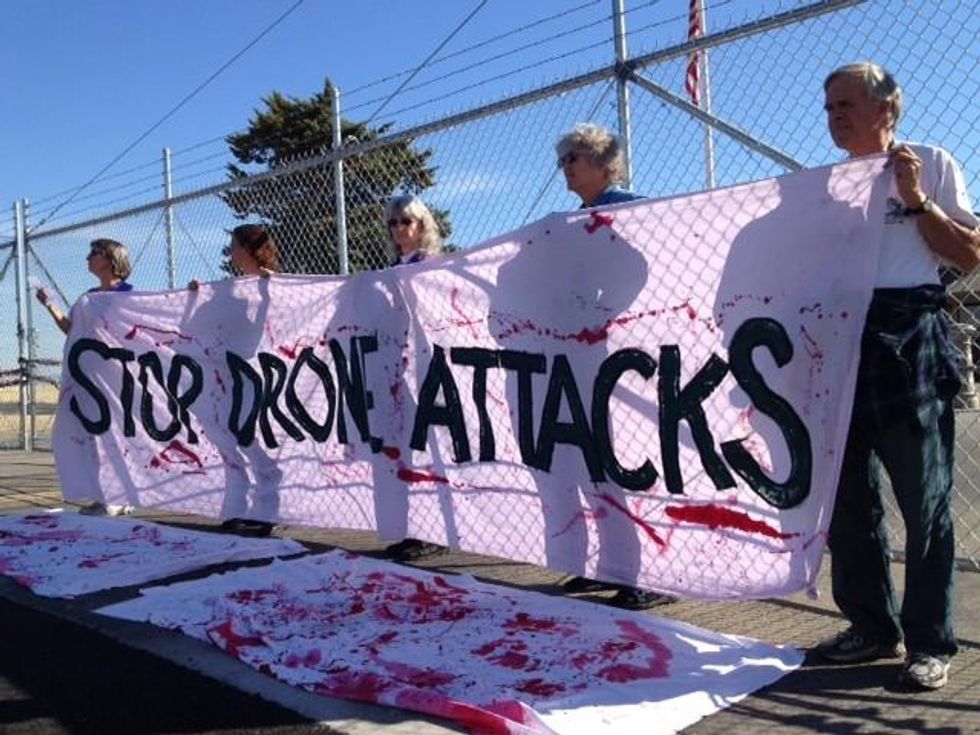Last week The Washington Post published a three-part series on the U.S. government's dramatic increase in targeted killing, and the steps being taken to institutionalize extra-judicial assassination as standard operating procedure far into the future. "Targeted killing is now so routine that the Obama administration has spent much of the past year codifying and streamlining the processes that sustain it," the series reports. (See the articles themselves here, here, and here.)
Nicknamed the "disposition matrix" and coordinated by presidential counterterrorism adviser John O. Brennan in conjunction with the National Counterterrorism Center (NCTC), this new system integrates drone technology, satellite surveillance, massive databases and presumed congressional authorization to target and kill persons of interest globally. While the focus at the moment is killing suspected operatives in Pakistan, Yemen and Somalia, the system is designed for "flexibility," with the capacity to cross borders at will.
This may include targeting U.S. citizens, as Glenn Greenwald of the Guardian stressed in a recent column. He quotes American Civil Liberties Union of Massachusetts's Kade Crockford, who noted in response to this story that
the real purpose of the NCTC -- despite its nominal focus on terrorism -- is the "massive, secretive data collection and mining of trillions of points of data about most people in the United States."
In other words, virtually all of us may find our way into the disposition matrix, depending on the predilections -- and definitions of terrorism -- of this or a future president. Greenwald underscores the danger this trend may pose to civil liberties:
What has been created here -- permanently institutionalized -- is a highly secretive executive branch agency that simultaneously engages in two functions: (1) it collects and analyzes massive amounts of surveillance data about all Americans without any judicial review let alone search warrants, and (2) creates and implements a "matrix" that determines the "disposition" of suspects, up to and including execution, without a whiff of due process or oversight. It is simultaneously a surveillance state and a secretive, unaccountable judicial body that analyzes who you are and then decrees what should be done with you, how you should be "disposed" of, beyond the reach of any minimal accountability or transparency.
This is not a new impulse. Many governments throughout history have craved the ability to control the populace, and some have created extensive surveillance and repression systems toward this goal. What is new is the technological capacity to carry this out with detailed specificity. The disposition matrix has the potential to literally sort entire populations into camps that are either "with us" or "against us" and dispose of them accordingly. Greenwald, rightly, is worried about this capacity, and about the political decision to enshrine it as a central component of the national security state:
The core guarantee of western justice since the Magna Carta was codified in the U.S. by the fifth amendment to the Constitution: "No person shall... be deprived of life, liberty, or property, without due process of law." You simply cannot have a free society, a worthwhile political system, without that guarantee, that constraint on the ultimate abusive state power, being honored.
This new regime is fraught with numerous physical, geopolitical, legal and moral dangers as it dramatically confirms a trajectory that has deep roots in our history and that has accelerated since Hiroshima: security through lethality.
There used to be a lot of talk about the "Free World." The West, led by the United States with its plethora of rights, was imbued with freedom, in contrast to the USSR's world of gulags and KGB surveillance. The Free World was a remarkably powerful idea that -- depending on how narrowly or broadly one defined freedom -- had a ring of truth to it. Of course, it was a slogan that glossed over inconvenient truths -- McCarthyism's broad-brush attack on civil liberties and the Jim Crow laws, to name two -- and that deepened the Cold War chill. But, as triumphalist as it sounded, it also was aspirational. It implied that freedom could grow and progress, that it could be the mood and character of one's society, and beyond. This can be a freer world, it seemed to say, and we can lead it there.
After September 11, 2001, though, this kind of thinking was trumped by the promise of safety manufactured by war abroad and increased surveillance at home. The choice was freedom or security, as if these are opposites. Now we are reaping the consequences of this bargain with the arrival of the disposition matrix.
This is a false choice. It's time to change course, and some people are trying to do just that. For several years, Code Pink and other organizations and networks have taken action to oppose the escalating use of drones around the world. Just this week, they joined the growing campaign at Beale Air Force Base outside Sacramento, California, where they rallied and engaged in nonviolent civil resistance. Meanwhile, 16 people from the very active Upstate Coalition to Ground the Drones and End the Wars were arrested at the New York National Guard Hancock Field in DeWitt, New York. (The "no drones" email list is currently exploring a larger nonviolent action there.)
This is a pivotal moment. Rooted in all that is currently being organized, it is time to broaden and deepen an increasingly powerful movement designed to help our society grasp what this fusion of technology and political power portends -- but also a movement that, step by step, removes the pillars of support for it.
Maybe, then, we will finally create a truly free world.
